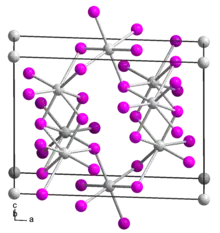 | |
| Names | |
|---|---|
| IUPAC name
tin(II) iodide | |
| Other names
stannous iodide | |
| Identifiers | |
3D model (JSmol) |
|
| ChemSpider | |
| ECHA InfoCard | 100.030.594 |
| EC Number |
|
PubChem CID |
|
| UNII | |
CompTox Dashboard (EPA) |
|
| |
| |
| Properties | |
| SnI2 | |
| Molar mass | 372.519 g/mol |
| Appearance | red to red-orange solid |
| Melting point | 320 °C (608 °F; 593 K) |
| Boiling point | 714 °C (1,317 °F; 987 K) |
| Related compounds | |
Other anions |
tin dichloride, tin(II) bromide |
Other cations |
lead(II) iodide |
Related compounds |
tin tetraiodide |
Except where otherwise noted, data are given for materials in their standard state (at 25 °C [77 °F], 100 kPa).
Infobox references | |
Tin(II) iodide, also known as stannous iodide, is an ionic tin salt of iodine with the formula SnI2. It has a formula weight of 372.519 g/mol. It is a red to red-orange solid. Its melting point is 320 °C, and its boiling point is 714 °C.[1]
Tin(II) iodide can be synthesised by heating metallic tin with iodine in 2 M hydrochloric acid.[2]
- Sn + I2 → SnI2
References
- ↑ Chemistry : Periodic Table : tin : compound data [tin (II) iodide]
- ↑ Greenwood, Norman N.; Earnshaw, Alan (1997). Chemistry of the Elements (2nd ed.). Butterworth-Heinemann. pp. 380–381. ISBN 978-0-08-037941-8.
This article is issued from Wikipedia. The text is licensed under Creative Commons - Attribution - Sharealike. Additional terms may apply for the media files.